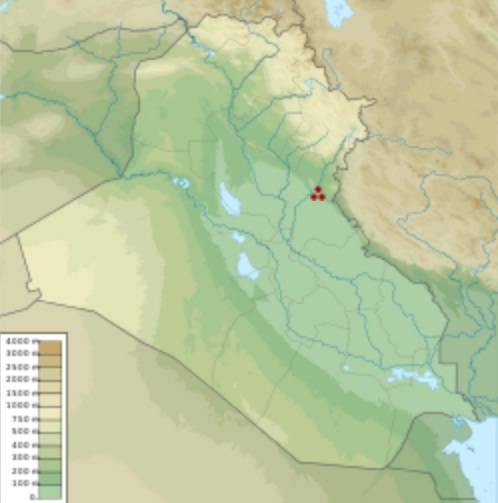
| TELL ABADA
Tell Abada shown within Iraq Location : Diyala Governorate, Iraq
Region : Mesopotamia
Coordinates : 34°6'0 N 45°7'12 E (approximate)
Type : tell
History :
Periods : Ubaid period
Tell Abada is a tell, or archaeological settlement mound, in Diyala Governorate (Iraq). Abada was excavated as part of the archaeological salvage operation to excavate sites that would be flooded by the reservoir of the Hamrin Dam. Excavations revealed occupation levels dating to the Ubaid 1-3 periods. The site is important because it was one of the few where an Ubaid period settlement could be excavated in its entirety.
The
site and its environment :
History
of research :
Occupation
history :
The architectural remains of level III consisted of two houses with multiple rectangular rooms, with gypsum plastered walls. These buildings have been interpreted as a pottery production location based on the presence of large storage jars, red ochre and three nearby kilns. The kilns were located in an open area and were of different types and shapes. In one case, it has been suggested that it could have been used both for firing pottery as well as food production. Large quantities of painted Samarra and Ubaid 1 were recovered with a wide array of different decorative geometric motifs, including ceramics with both Samarra and Ubaid 1 characteristics. There seems to have been a clear break in the occupation history between levels III and II.
Level II consisted of 11 buildings which were separated by streets and narrow lanes. The buildings share a distinct design with a tripartite plan with rooms arranged around a T-shaped courtyard. The walls were constructed of mudbricks. One of the largest buildings (building A), in the center of the site, had exterior walls decorated with buttresses, indicating that it may have had a special function. Designs on the painted pottery included geometric motifs as wells as more naturalistic depictions. Pottery decorated with incisions and impressions was also common. Other finds included animal and human clay figurines, stone tools such as querns, mortars, mace heads, and bone tools such as needles and spatulas.
A certain degree of continuation existed between the architecture of level II and level I. Painted pottery was common and often wheel-thrown, and decorations shared characteristics with those observed on both Northern and Southern Ubaid sites. Decoration was both geometric as well as naturalistic.
Burials
:
Source :
https://en.wikipedia.org/ |
